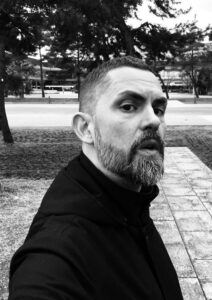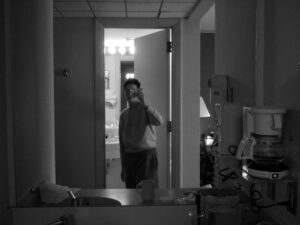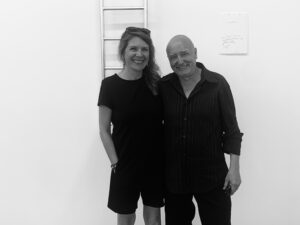- stöckerselig (Basel/CH)
- Anna Rudolf (Amsterdam/NL)
- Christian Aberle
- Sylvie Boisseau + Frank Westermeyer
- Reinhard Doubrawa
- Claudia-Maria Luenig
- Ulrich Nausner
Post Future / Nach der Zukunft
The invited artists reflect on life after the future and invite us to readjust our perception.
In our 60th exhibition, with the group exhibition Post Future / Nach der Zukunft, we are responding to current attitude of life of the afterwards, which dominates in many areas. So we live in post-corona, post-anthropocene, post-future and post-certainties times and seem to be caught in an endless loop of backwards reflections.
We are more stuck in the after than in the before. The future is not bright because we don’t think about it at all. We feel like survivors of a crisis or many crises that seem to have no end and in this after, the future does not come into play.
The artists in the exhibition act and react in their very different working methods like seismographs to the subtlest shocks and atmospheric disturbances of social upheavals and in doing so open up reflective levels outside of theoretical analyses with their works. – Not as therapy, but to readjust perceptions.
participating artists:
Christian Aberle/Cologne – Melas Eichhorn/Hamburg – Sylvie Boisseau + Frank Westermeyer/Berlin+Geneva – Reinhard Doubrawa/Cologne – Claudia-Maria Luenig/Vienna – Ulrich Nausner/Vienna – Anna Rudolf/Amsterdam+Basel – stöckerselig/Basel
Anna Rudolph

Anna Rudolf | image: Flip Feij
Anna Rudolf was born and grew up in Basel, Switzerland. She has lived in Amsterdam for 30 years. She studied at the School of Design in Basel and then fine art at the Gerrit Rietveld Academy in Amsterdam. She received the Derebbel Prize for her final thesis. Drawing has become her most important and certainly most personal means of expression in recent years. In the drawing process, she deals with questions about herself and her relationship to the world. In small formats as well as in large drawing installations, she creates stubborn animal and human figures that relate to one another in unmistakable lines. Her work is shown internationally, and she regularly exhibits in galleries, museums and art institutions in Holland, Belgium, Germany and Switzerland. A selection of her exhibitions are: BIG ART, Amsterdam; puntWG, Amsterdam; Amsterdam Drawing, NL; Witteveen Visual Art Centre, Amsterdam; Kunstvereniging Diepenheim, NL; De Vishal, Haarlem, NL; Galerie Vrijdag, Antwerp, BE; Künstlerforum, Bonn; Ostrale, International Exhibition of Contemporary Arts, Dresden; Kunsthaus Baselland, Muttenz, CH.
Drawing for me is a question of identity. I draw to get something in front of me to relate to and think about. In it’s directness it refers to my feeling and thougts. My drawings are like transparant buildings with all traces of creation visible. I challenge the viewer to read a work from the process and from results that do not necessarily lead to a conclusion.
In 2020 she won the Visarte ‘Corona Call’ Prize, CH, with the drawing installation Cell Space and in 2021 she received a project grant from the Mondriaan Fonds, NL.
Ulrich Nausner
Ulrich Nausner is an Austrian artist. He lives and works in Vienna, Austria. In his conceptual works and installations, he deals with patterns of perception and the context of meaning of information and language. He studied at the University of Art and Design in Linz.
His numerous awards and scholarships include: 2020 Austrian State Scholarship for Fine Arts, BKA, AT; 2019 Artist in Residence, Schloss Wiespach, Hallein, AT; 2016 Fellowship Prize of the State of Salzburg and the Salzburg Art Association, AT; 2014 Artist in Residence, Warsaw, State of Salzburg, PL; 2012 Austrian Start-up Scholarship for Fine Arts, BM:UKK, AT. His works are shown internationally and are part of collections including the MAK Museum of Applied Arts, the Vienna Museum Collection, and the State of Salzburg Collection.
Ulrich Nausner works primarily with language, playing with typography and graphic representation, and illuminating the social, taking his cues from conceptual art. His simple prints quickly make it clear that there are hardly any tactile elements in the production process and that digital technology is the most important tool. This choice is not only based on aesthetics, but also seems to be rooted in his research, as most of it takes place online, using search engines, documents available online and their digital manipulation to the point of exhaustion. (Anna Tzini on Hypertext Paintings)
Christian Aberle
Christian Aberle | image: Christian Aberle
Aberle lives and works in Cologne. He studied at the State Academy of Fine Arts, Karlsruhe.
There are a wide variety of works to discover in Christian Aberle’s drawings: on smaller formats and with minimal means, often little more than colored pencils or ink, deliberately reduced, broken down to the essentials. One characteristic that Christian deliberately takes to the extreme is the play with technical perfection: his drawings are old master sheets, perfectly executed in their craftsmanship – but that is not the point at all. They are defiant, time-wrested, highly controlled works. In his drawings, Christian manages to make abstract things visible, almost tangible. – What is he concerned with? The in-between, the actually inconspicuous, the irrelevant, the other. What remains after everything has already been there, everything has already been said, everything has been asked – what one considers to be permanent.
(Frauke Boggasch, from: We do not live in the time of the cloudburst/an approach to the drawings by Christian Aberle, in: Dritte Hälfte, StrzeleckiBooks, Kön, 2013)
Melas Eichhorn
Melas Eichhorn | image: Melas Eichhorn
Eichhorn studied painting and drawing at the Academy of Fine Arts.
He works as an artist and mediator in Hamburg.
In his artistic work, he interacts with different media, which he transfers into new contexts. The result is narratives and variables of meaning that are perceived casually are perceived casually – and can have a suggestive effect.
As Christian Aberle writes in his text on the exhibition “ Die Grosse Scham ” by Melas Eichhorn.
Melas Eichhorn’s particular strength lies in creating ambience and situations. For Melas’ exhibition practice, the design […] of a certain atmosphere or milieu replaces the presentation of a singular art object, “1 and even more: ‘[Melas] spatializes (the) space in the exhibition ’2
This approach can also be applied to the audio collages he speaks himself, in which he combines recorded fragments into short narratives.
The narrative voice, pauses, cuts and sounds create fictitious spaces and an intimate atmosphere.
______________
1 Quote Stefan Römer, in: Christian Kravagna, Ambient Art, in: DuMonts Be- gri slexikon zur
zeitgenössischen Kunst, ed. Hubertus Butin, DuMonts Literatur und Kunst Verlag, Cologne, 2002, p. 8. (In the text, the word “diese” has been replaced by “Melas”, author’s note)
2 Simon Starke, that ‘s wild!, in: Melusine Eichhorn, Melancholia
stöckerselig
The artist couple stöckerselig consists of Annette Stöcker, born in Biel (CH) in 1962. She completed her training as a potter at the Ecole des Arts décoratifs in Geneva, and Christian Selig, born in St. Gallen (CH) in 1954, a graduate of the F&F School for Experimental Design in Zurich. He studied with various Japanese Zen masters and was Erich Wiesner’s assistant on art-in-architecture projects in Berlin.
Since 1987 they have been building an artistic universe together by discovering and understanding the world. Their work consists of drawings, photography, video and texts, from which spaces (physical and mental) emerge that reflect the magic of everyday life. The intensive and open exploration of images and archetypes in their respective environments as well as their own archives serve as a building block that is the core and starting point of their works.
Sylvie Boisseau & Frank Westermeyer
Sylvie Boisseau & Frank Westermeyer | image:
Sylvie Boisseau & Frank Westermeyer live and work in Berlin and Geneva (CH), The German- French artist couple has been working together since 1996 under the name Boisseau/Westermeyer, among other artistic works, on video and film installations that are shown internationally in art galleries and at festivals.
With ƒ, an experimental figure they created in 1997, they try to show the extent to which language is permeated by projections and a wide variety of expectations. Their works have been shown internationally at festivals, conferences and exhibition venues, most recently at the Irma Republic in Bern, the Centre d’art contemporain in Geneva, the Große Kunstschau Worpswede at the transmediale Berlin and at the Kino der Kunst festival in Munich.
Claudia-Maria Luenig
Claudia-Maria Luenig | image:
Born in Herbern (D), Luenig currently lives and works in Vienna/AT. In 1980 she received a diploma in chemical engineering. From 1985 – 1999 Luenig lived and worked in Canberra and Melbourne, where she earned a Bachelor of Arts (Sculpture) and a Masters of Arts in Interior Design in 1992 and 1998 respectively. She has participated in national and international exhibitions in Albania, Armenia, Germany, Bulgaria, France, Greece, Australia, Italy, North Macedonia and China. A series of international artist residencies includes a 4-month stay in Paris in 2019.
From 2004-2023 she ran the autonomous exhibition space BASEMENT, which exhibited Austrian and international artists in dialogue on an annual theme. Since May 2023, the exhibition space in Grundsteingasse no longer exists, but the concept of BASEMENT continues to operate as BASEMENT ON THE MOVE.
Claudia-Maria Luenig’s drawings, collages and textile sculptures explore the presence and absence, the physical and metaphorical boundaries and trajectories of the body in relation to its environment. The works not only literally focus on the vulnerable nature of the body’s relationship to its environment and the individual connections and boundaries between its organs, but they raise deeper questions and concerns of crucial importance.
Reinhard Doubrawa
Reinhard Doubrawa | image:
Born in Treysa/GER, Doubrawa currently lives and works in Cologne. He studied from 1990 to 1995 at the Kassel Art Academy, in 1991 under Fritz Schwegler at the Düsseldorf Art Academy and completed his studies in 1995 as a master student under Urs Lüthi. Since 1998 he has held various teaching positions, including at the Kassel Art Academy, TU Eindhoven, Luca School of Arts/Ghent, RWTH Aachen, Bauhaus Dessau, Bochum University, Kask, Gent.
Doubrawa’s artistic practice is cross-media and cross-genre. It includes drawing, painting, photography, objects, graffiti, installation and in-situ projects. He deals with questions about the creation of meaning in connection with everyday signs and codes. His work mainly moves in the area between language and image.
“Doubrawa is more interested in the actions related to form and meaning. This is about (visual) expression, imagery (what message is conveyed by an image, how is it conveyed, and is it actually conveyed?), and how our language is tied to meaning outside of itself. Doubrawa asks in what form we acquire ‘our meaning’, how this meaning influences form (and vice versa), and how insane (or ambiguous) this relationship is in reality.”
(Godart Bakkers, 2017)
Material
- invitation card
- press release
- article by Thomas Kliemann in General Anzeiger Bonn from January 25/26, 2025 (in German)




















